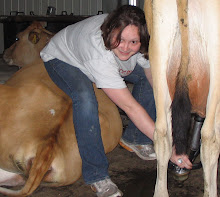The idea started when Kathy and I were wondering how Finger Lakes Rieslings compare with the traditional German ones. We should taste them and find out! Of course, it snowballed from there, and food pairings and Rieslings from other regions in the New World. We finally got together and had the event. We went a little overboard with both food and wine ("Doesn't make you a bad girl," as Pat would say), so it was a little overwhelming. Not only did we learn about the different Rieslings, but we enjoyed them.
We found the German Rieslings overall had a rich texture and relatively full body. Kathy did a great job picking out three bottles with different levels of sweetness. Honey was the flavor that stood out, to varying degrees in each. There were also the classic apple and pear flavors, more in baked or dried forms than fresh. However, all three German wines were well balanced.
The
2005 Peter Mertes Privatkelleri Spätlese (sweet, late harvest) was the prime example of this: very golden in color, creamy in texture and sweet honey and fruit on the tongue, but with a comparably clean finish. It paired surprisingly well with many of the foods, particularly the apple and onion sausages.
The
2008 Pölka Dot Riesling (semi-dry/semi-sweet) was a lighter, more lively (if less complex) take on these flavors. Honey and baked apple were still prominent. It reminded us a bit of Lamoreaux's Semi-Dry Riesling. It is clear from the flashy, contemporary look of the bottle that this wine is designed to be a crowd pleaser, and it was exactly that. It turned out to be one of the favorites of the evening. This wine is ideal for quaffing, but also paired nicely with the foods we sampled it with.
The
2007 Franz Wilh. Langguth Erben Kabinett (dry) was a delicate, "calm" wine. The dry, freshness worked with the cheeses, particularly the brie, and was a pleasant palate cleanser between tastes. However, it's mild flavors were easily overpowered by most of the food pairings.
The
2007 Snap Dragon Riesling (semi-dry/semi-sweet) from California fell somewhere between the Old and New World wines, and shared many qualities with the Pölka Dot (comparable sweetness.) This must be the type of Rieslings being made for the American market. There were strong honey notes on the nose, though less on the palate with a slight spiciness on the finish. It paired well with foods as diverse as wasabi peas to sweet potato gratinée.
2008 Chateau Ste Michelle Riesling (dry) from Washington's Columbia Valley had a delightful effervescence and crisp notes of citrus and perhaps honeydew. This dry Riesling was also great with the cheeses. I especially liked it with the Raclette.
While I lived in London, I developed a strong affinity for the wine from New Zealand, so I really wanted to include one in this tasting. I searched high and low, and was thrilled to find the
2007 Kim Crawford Dry Riesling. It was quite bracing and austere, with a crisp minerality (almost a bit briny) and flavors of lime and all things green, but little of the fruit we noticed in the other Rieslings. The best pairing was with the (green) wasabi peas, and I bet it would be a great wine with sushi (or oysters!)
Of course we were already familiar with the Finger Lakes Rieslings, but it was interesting to have them as a basis for comparison.
Standing Stone's 2008 Riesling was awarded 89 points in Wine Spectators, and I had a bottle leftover from Thanksgiving (when everyone decided to drink red.) It was most similar to the Washington and New Zealand wines, light and crisp. It was slightly effervescent and had notably more fruit flavors (apple, pear, citrus.)
The Pear & Fennel Flatbread was designed by Red Newt's Deb Whiting to pair the
2008 Lamoreaux Landing Red Oak Vineyard Riesling. It was a good pairing, but the peppery arugula overpowered the wine a bit. I think I just put too much on. Next time, I'll use milder, baby arugula. After tasting Rieslings from around the world and coming back home to the Finger Lakes, I tasted this wine with a new palate and persepctive. This wine, made from the first harvest from these particular vines, is light and friendly. Lush flavors of apple and pear stand out, with notes of honey, as a nod to the grape's German roots.
The evening was rounded out with a special treat: apple turnovers with 2007 Lamoreaux Landing Riesling Ice, perhaps the best pairing of all-- but how could you go wrong?

We look forward to doing tasting evenings like this again, exploring other regions and varietals. I learned a lot from putting together this evening. In future, we will stick to fewer wines (3-5). This will make it easier to keep track of each one, and to keep them colder (if necessary). Having a dedicated glass for each wine will also help with this, as will place mats giving the particulars of each wine. To better evaluate the wines and their food pairings, we have to give the evening more structure. (Not arriving hungry and thirsty is a good start!) First, all the wines should be tasted on their own. Then the food is introduced slowly, allowing for each wine to be sampled with each dish. This will also keep us from predetermining which wine we think should go with the food, and allow for those wonderfully delicious surprises. What fun!












































